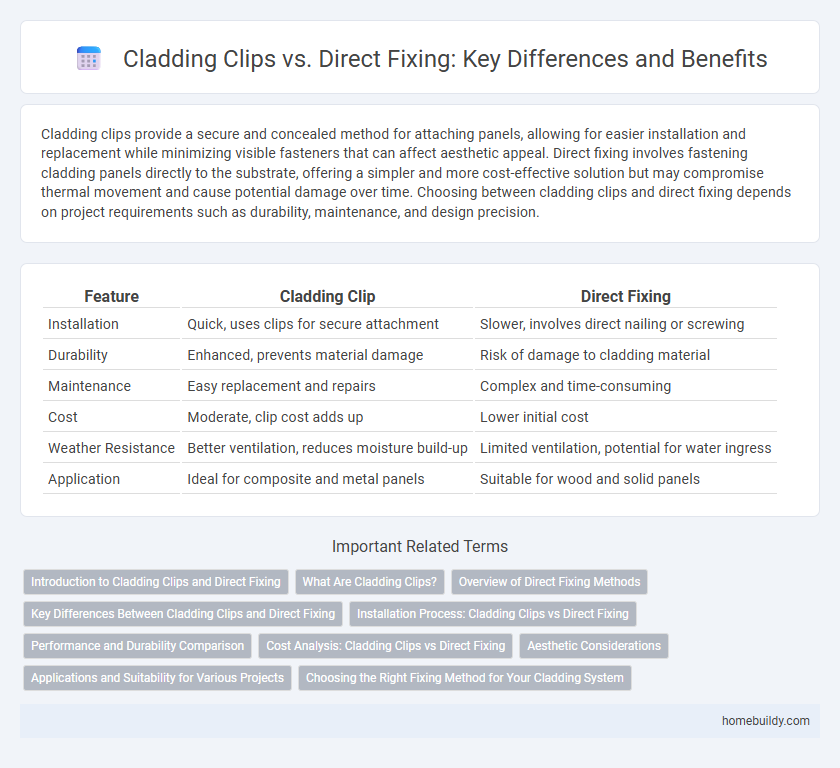Cladding clips provide a secure and concealed method for attaching panels, allowing for easier installation and replacement while minimizing visible fasteners that can affect aesthetic appeal. Direct fixing involves fastening cladding panels directly to the substrate, offering a simpler and more cost-effective solution but may compromise thermal movement and cause potential damage over time. Choosing between cladding clips and direct fixing depends on project requirements such as durability, maintenance, and design precision.
Table of Comparison
| Feature | Cladding Clip | Direct Fixing |
|---|---|---|
| Installation | Quick, uses clips for secure attachment | Slower, involves direct nailing or screwing |
| Durability | Enhanced, prevents material damage | Risk of damage to cladding material |
| Maintenance | Easy replacement and repairs | Complex and time-consuming |
| Cost | Moderate, clip cost adds up | Lower initial cost |
| Weather Resistance | Better ventilation, reduces moisture build-up | Limited ventilation, potential for water ingress |
| Application | Ideal for composite and metal panels | Suitable for wood and solid panels |
Introduction to Cladding Clips and Direct Fixing
Cladding clips provide a secure, non-penetrative method to attach cladding panels, allowing for thermal expansion and easier maintenance compared to direct fixing. Direct fixing involves mechanically attaching cladding to the substrate, which can lead to potential issues like water ingress and limited movement accommodation. Choosing between cladding clips and direct fixing depends on factors like building design, material type, and weather exposure.
What Are Cladding Clips?
Cladding clips are specialized fasteners designed to securely attach external cladding panels to a building's framework, providing a discreet and durable fixing method without penetrating the panel surface. Unlike direct fixing, which involves drilling through the cladding material, cladding clips allow for thermal movement and reduce the risk of damage or water ingress, improving the overall facade performance. These clips are engineered for various materials such as aluminum, timber, or composite panels, ensuring flexibility and ease of installation across modern architectural applications.
Overview of Direct Fixing Methods
Direct fixing methods involve attaching cladding materials directly to the building structure without the use of intermediate components like cladding clips, providing a more streamlined installation process. These methods typically include mechanical fasteners such as screws or bolts drilled into the substrate, ensuring strong retention and direct load transfer. Direct fixing is often preferred for lightweight panels or where minimal air gaps are required between the cladding and the building envelope.
Key Differences Between Cladding Clips and Direct Fixing
Cladding clips provide a concealed fastening system that allows for thermal expansion and ventilation behind the cladding, improving the building's durability and energy efficiency compared to direct fixing. Direct fixing involves attaching cladding panels directly to the substrate, which can result in less flexibility and potential for moisture accumulation, increasing the risk of corrosion and structural damage. Cladding clips also facilitate easier installation and replacement of panels, making them a preferred choice for modern facade systems.
Installation Process: Cladding Clips vs Direct Fixing
Cladding clips enable a quicker and more precise installation process compared to direct fixing by providing a secure, adjustable mounting system that reduces the need for on-site adjustments and corrections. Direct fixing requires drilling or screwing through the cladding material into the substrate, which can increase installation time and risk damage to panels. Using cladding clips also promotes better thermal expansion accommodation and alignment, enhancing overall facade performance and longevity.
Performance and Durability Comparison
Cladding clips provide superior performance by allowing for thermal expansion and contraction, reducing stress on the facade system, while direct fixing methods can lead to faster material degradation due to rigid attachment. Clips enhance durability with corrosion-resistant materials and facilitate easier maintenance or replacement of panels, unlike direct fixing which often compromises the lifespan of the cladding through constant exposure to mechanical strain. Performance tests consistently show that cladding clip systems maintain structural integrity and weather resistance better over time compared to direct fixed cladding installations.
Cost Analysis: Cladding Clips vs Direct Fixing
Cladding clips offer a cost-effective solution by reducing labor time and minimizing structural alterations compared to direct fixing methods, which often require additional insulation and weatherproofing materials. The initial investment in cladding clips can be higher but leads to long-term savings through improved thermal performance and easier maintenance. Direct fixing may appear cheaper upfront but incurs greater expenses in potential repairs and energy inefficiency over the building's lifecycle.
Aesthetic Considerations
Cladding clip systems offer superior aesthetic appeal by providing a seamless facade without visible fasteners, enhancing the overall visual integrity of the building exterior. Direct fixing methods often result in exposed screws or anchors, which can disrupt the architectural design and limit design flexibility. Cladding clips enable uniform panel alignment and reduce thermal bridging, contributing to both visual and functional benefits in modern construction.
Applications and Suitability for Various Projects
Cladding clips offer superior adaptability for complex architectural designs and uneven surfaces compared to direct fixing methods, making them ideal for high-rise buildings and renovation projects. These clips ensure enhanced ventilation and thermal performance by allowing a ventilated cavity behind the cladding, which direct fixing lacks. Suitable for both timber and metal frameworks, cladding clips provide versatility across commercial, residential, and industrial applications where long-term durability and ease of maintenance are priorities.
Choosing the Right Fixing Method for Your Cladding System
Cladding clips provide enhanced ventilation and thermal expansion advantages compared to direct fixing, reducing moisture buildup and preventing long-term damage. Selecting the appropriate fixing method depends on factors such as substrate type, environmental exposure, and desired maintenance levels. Proper evaluation ensures structural integrity and optimal performance of the cladding system over time.
Cladding clip vs Direct fixing Infographic

 homebuildy.com
homebuildy.com